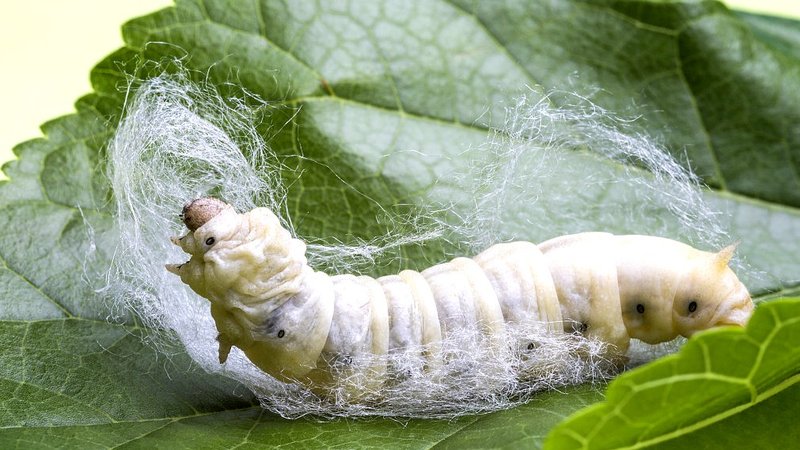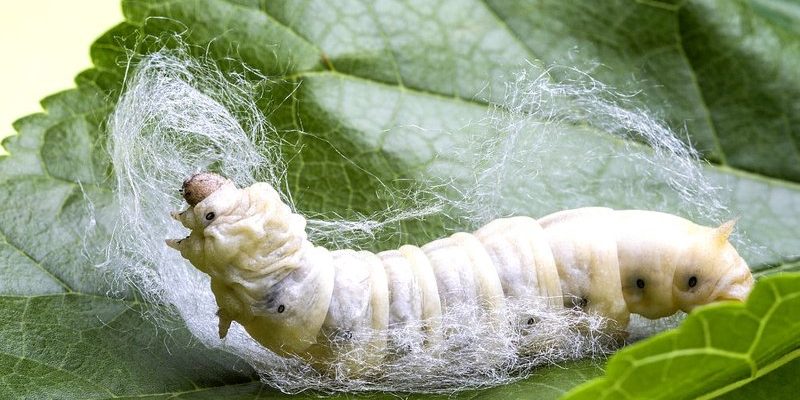
Let’s dive a little deeper into these differences. Whether you’re curious about the silk-making process or just interested in the natural world, understanding these two types of silkworms can give you a new appreciation for this delicate fabric. So, grab a cup of coffee and let’s chat about what makes wild and domesticated silkworms unique.
What Are Wild Silkworms?
Wild silkworms, or *antheraea mylitta*, are fascinating creatures that thrive in their natural habitats, such as forests and jungles. These silkworms have adapted over many years to live in the wild, spinning their silk in trees and bushes. Unlike their domesticated cousins, wild silkworms are often more resilient and better equipped to fend for themselves.
One interesting fact about wild silkworms is that they usually feed on a variety of leaves from different trees, like oak and mulberry. This varied diet helps them develop unique flavors in their silk, making it richer and more textured. The silk produced by wild silkworms is often less uniform than that of domesticated ones, but it carries a charm that many silk enthusiasts adore.
Wild silkworms also face challenges that domesticated ones don’t. Predators, harsh weather, and food shortages can affect their survival. This is part of the reason why their population is often less stable. But here’s the thing: these challenges also make wild silk special. Artisan weavers often seek it out for its unique character.
What Are Domesticated Silkworms?
Now let’s shift gears and talk about *domesticated silkworms*, primarily the *Bombyx mori*. These little guys are the stars of the silk industry, raised in controlled environments like farms and silkworm houses. Unlike wild silkworms, domesticated ones have been bred selectively for thousands of years to produce high-quality silk while being easier to manage.
Domesticated silkworms primarily munch on mulberry leaves, which are rich in nutrients. This specific diet leads to the production of silk that is smooth, shiny, and highly coveted for clothing and textiles. It’s like a fine gourmet meal vs. a hearty homecooked dish—each has its appeal, but they taste and feel different.
Another important distinction is that domesticated silkworms often don’t have the same survival instincts as wild ones. They don’t fly and have lost the ability to survive in the wild. This makes them more dependent on humans but also allows us to control their breeding and silk production better.
Silk Production Process: A Closer Look
The silk production process is a fascinating journey, regardless of the type of silkworm. For *domesticated silkworms*, it starts from the eggs, which hatch into larvae. These tiny caterpillars munch their way through mulberry leaves until they’re ready to spin their cocoons. In about 25 to 30 days, they’ll cocoon themselves in a protective layer of silk threads.
Interestingly, the silk threads from domesticated silkworms can be up to 1,000 meters long! That’s quite a lot of silk coming from one little worm. Once the cocoons are complete, they’re harvested and boiled to extract the silk fibers. This process is a dance between art and science, ensuring that the silk is soft, shiny, and ready for weaving into glorious garments.
With wild silkworms, the process differs slightly. In the wild, cocoons are often collected but can be less predictable in quality. The silk threads can be shorter and vary in texture, leading to a more rustic look. This uniqueness is part of what makes wild silk appealing, especially for certain artisan projects.
Key Differences in Appearance and Quality
When it comes to *appearance*, domesticated and wild silks are worlds apart. Domesticated silk is known for its **smooth and shiny** texture, often used in high-end fashion and luxurious bedding. It’s like the polished surface of a beautifully crafted table—sleek and inviting.
In contrast, wild silk tends to have a more *textured* and *irregular* appearance. You might think of it like a handwoven basket—unique, with little imperfections that tell a story. This type of silk is often used in artisanal crafts or traditional garments where character is cherished over uniformity.
The **quality** of silk can also vary considerably. Domesticated silk usually promises consistent quality, while wild silk can be somewhat unpredictable. This unpredictability is great for those who value individuality in textiles but might not suit every commercial purpose.
Environmental Impact and Sustainability
The environmental impact of silk production is another vital consideration. Domesticated silkworm farming can have significant effects on the landscape, especially when large-scale farming practices are used. These practices might include the use of pesticides and fertilizers that could disrupt local ecosystems.
Wild silkworms, on the other hand, often contribute to biodiversity in their natural habitats. They rely less on human intervention and support ecosystems as they feed on various plants. However, the challenge comes from *overharvesting* and habitat destruction, which threaten their populations.
By choosing to support sustainable practices, we can help protect both wild habitats and responsible silk farming methods. It’s essential to consider where your silk comes from, ensuring that it aligns with your values regarding the environment and animal welfare.
Uses of Wild vs. Domesticated Silk
The uses of silk from wild and domesticated silkworms can differ dramatically. Domesticated silk is a staple in the fashion industry, prized for its soft hand and luxurious finish. Designers often turn to domesticated silk for dresses, suits, and home textiles like curtains and comforters.
In contrast, wild silk is often used for more specialized products, such as traditional wear and artisanal crafts. Its unique feel and texture lend themselves well to items that celebrate craftsmanship and individuality. For instance, in some cultures, wild silk is woven into ceremonial garments or used in handmade accessories.
So, if you’re picking out silk for a project or purchase, consider the end use. Do you want something flashy and polished, or are you searching for character and uniqueness? Your purpose can help guide your choice.
Final Thoughts: Embracing the Diversity of Silkworms
When you think of silk, it’s easy to picture just one kind of fabric, but the reality is so much richer. The differences between *wild and domesticated silkworms* remind us of the beauty found in nature and human ingenuity. From the resilient wild silkworms that create distinctively textured silk to the carefully bred domesticated ones producing luxurious fabric, there’s something special about both.
Whether you’re wearing a silk scarf or enjoying a silk pillowcase, you’re part of a long tradition rooted in both nature and culture. It’s worth taking a moment to appreciate the journey that silk takes from silkworm to your hands. So the next time you encounter silk, think of the wild forests and gentle farms that made it all possible. Embrace the richness of diversity and the stories woven into every fiber.

